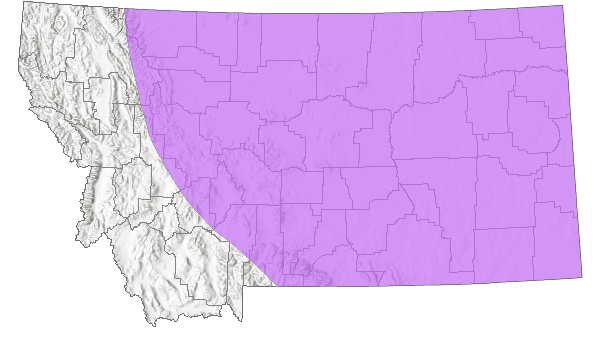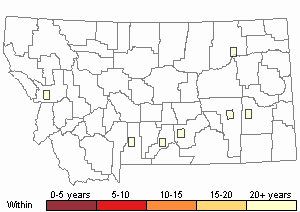View in other NatureServe Network Field Guides
NatureServe
Montana
Utah
Wyoming
Idaho
Wisconsin
British Columbia
South Carolina
Yukon
California
New York
Crenulated Grasshopper - Cordillacris crenulata
General Description
The following comes from Helfer (1971), Otte (1981), Capinera and Sechrist (1982), Vickery and Kevan (1985), McDaniel (1987), Pfadt (2002), Capinera et al. (2004), and Scott (2010). A small brownish grasshopper marked with dark, bold stripes. The side of the head behind the eye is marked with a black triangular stripe which broadens onto the lateral side of the pronotum. The hind tibia is pale gray to yellowish, often becoming blackish at the distal end.
Phenology
Overwinters in the egg stage. Adults occur from June to mid-September (Capinera et al. 2004, Capinera and Sechrist 1982, Otte 1984, Pfadt 2002, Scott 2010, and Vickery and Kevan 1985).
Diagnostic Characteristics
The following is taken from Helfer (1971), Otte (1981), Capinera and Sechrist (1982), Vickery and Kevan (1985), McDaniel (1987), Pfadt (2002), Capinera et al. (2004), and Scott (2010). Male body length is 13 mm to 19 mm and females 16 mm to 26 mm. The forewings (tegmina) have a wavy or scalloped (crenulated) dark stripe which is diagnostic for this species. A dark stripe runs from below the eye to top of the mandibles.
Can be confused with its congener the
Spotted-wing Grasshopper (
Cordillacris occipitalis), which lacks the scalloped stripe on the forewing.
Species Range
Montana Range
Range Descriptions

 Native
Native
Range Comments
Distributed across the Great Plains from Montana and North Dakota, southward to Arizona, New Mexico and west Texas. Also found in the Great Basin of Utah and Nevada. There is much overlap with the distribution of the Spotted-wing Grasshopper (C. occipitalis). In Montana, it has been reported in 24 counties (Capinera et al. 2004, Capinera and Sechrist 1982, Otte 1984, Pfadt 2002, Scott 2010, and Vickery and Kevan 1985).
Observations in Montana Natural Heritage Program Database
Number of Observations: 7
(Click on the following maps and charts to see full sized version)
Map Help and Descriptions
Relative Density

Recency


 (Observations spanning multiple months or years are excluded from time charts)
(Observations spanning multiple months or years are excluded from time charts)
Habitat
Inhabits shortgrass prairie, gravelly areas, heavily grazed sites, and areas that are thinly vegetated (Brust et al. 2008, Capinera et.al. 2004, Capinera and Sechrist 1982, Otte 1984, Pfadt 2002, and Vickery and Kevan 1985).
Food Habits
The Crenulated Grasshopper is a grass feeder, favoring
blue gramma (
Bouteloua gracilis) but feeds on other species such as hairy grama,
buffalograss (
Munroa squarrosa),
witch panicgrass (
Panicum capillare),
needle-and-thread (
Stipa comata),
needleleaf sedge (
Carex duriuscula), and some forbs such as tansy aster and flax (Capinera et al. 2004, Capinera and Sechrist 1982, Helfer 1971, Otte 1984, Pfadt 2002, Vickery and Kevan 1985).
Reproductive Characteristics
The following comes from Otte (1984), Pfadt (2002), and Vickery and Kevan (1985). Courting males walk about on bare ground raising and lowering their hind femora. At the same time he raises and lower his antennae, touching the substrate. Females lay their eggs in patches of
blue gramma (
Bouteloua gracilis) producing two to three eggs per oviposit, but do not produce a pod to protect them. Upon hatching, the nymphs pass through 4 instars (sometimes 5 instars) before reaching the adult stage.
References
- Literature Cited AboveLegend:
 View Online Publication
View Online Publication Brust, M.L, W.W. Hoback, and R.J. Wright. 2008. The Grasshoppers of Nebraska. Lincoln, NB: University of Nebraska Extension Service, APHIS.
Brust, M.L, W.W. Hoback, and R.J. Wright. 2008. The Grasshoppers of Nebraska. Lincoln, NB: University of Nebraska Extension Service, APHIS. Capinera, J.L. and T.S. Sechrist. 1982. Grasshoppers of Colorado: Identification, Biology, and Management. Fort Collins, CO: Colorado State University Experiment Station, Bulletin 584S. 161 p.
Capinera, J.L. and T.S. Sechrist. 1982. Grasshoppers of Colorado: Identification, Biology, and Management. Fort Collins, CO: Colorado State University Experiment Station, Bulletin 584S. 161 p. Capinera, J.L., R.D. Scott, and T.J. Walker. 2004. Field Guide to Grasshoppers, Katydids, and Crickets of the United States. Ithaca, NY. Cornell University Press.
Capinera, J.L., R.D. Scott, and T.J. Walker. 2004. Field Guide to Grasshoppers, Katydids, and Crickets of the United States. Ithaca, NY. Cornell University Press. Helfer, J.R. 1971. How to Know the Grasshoppers, Crickets, Cockroaches, and Their Allies. Revised edition (out of print), Mineola, NY: Dover Publications.
Helfer, J.R. 1971. How to Know the Grasshoppers, Crickets, Cockroaches, and Their Allies. Revised edition (out of print), Mineola, NY: Dover Publications. McDaniel, B. 1987. Grasshoppers of South Dakota. Brookings, SD: South Dakota Agricultural Experiment Station, Bulletin TB 89.
McDaniel, B. 1987. Grasshoppers of South Dakota. Brookings, SD: South Dakota Agricultural Experiment Station, Bulletin TB 89. Otte, Daniel. 1981. The North American Grasshoppers. Volume 1. Acrididae (Gomphocerinae and Acridinae). Harvard University Press. 275 pp.
Otte, Daniel. 1981. The North American Grasshoppers. Volume 1. Acrididae (Gomphocerinae and Acridinae). Harvard University Press. 275 pp. Pfadt, R.E. 2002. Field Guide to Common Western Grasshoppers, 3rd edition. Laramie, WY: Wyoming Agricultural Experiment Station, Bulletin 912, modified by S. Schell and S. Schell for electronic publication. Accessed 19 February 2020. http://www.uwyo.edu/entomology/grasshoppers/field-guide/index.html#fieldguidetoc
Pfadt, R.E. 2002. Field Guide to Common Western Grasshoppers, 3rd edition. Laramie, WY: Wyoming Agricultural Experiment Station, Bulletin 912, modified by S. Schell and S. Schell for electronic publication. Accessed 19 February 2020. http://www.uwyo.edu/entomology/grasshoppers/field-guide/index.html#fieldguidetoc Scott, R.D. 2010. Montana Grasshoppers, Katydids, and Crickets A Pictorial Field Guide to the Orthoptera. MagpieMTGraphics, Billings, MT.
Scott, R.D. 2010. Montana Grasshoppers, Katydids, and Crickets A Pictorial Field Guide to the Orthoptera. MagpieMTGraphics, Billings, MT. Vickery, V. R. and D. K. M. Kevan. 1985. The grasshopper, crickets, and related insects of Canada and adjacent regions. Biosystematics Research Institute, Ottawa, Ontario. Publication Number 1777. 918 pp.
Vickery, V. R. and D. K. M. Kevan. 1985. The grasshopper, crickets, and related insects of Canada and adjacent regions. Biosystematics Research Institute, Ottawa, Ontario. Publication Number 1777. 918 pp.
- Additional ReferencesLegend:
 View Online Publication
View Online Publication
Do you know of a citation we're missing? Anderson, N.L. 1951. Field studies on the biology of range grasshoppers of southeastern Montana. M.Sc. Thesis. Bozeman, Montana: Montana State University. 96 p.
Anderson, N.L. 1951. Field studies on the biology of range grasshoppers of southeastern Montana. M.Sc. Thesis. Bozeman, Montana: Montana State University. 96 p. Anderson, N.L. 1962. Grasshopper-vegetation relationships on Montana grasslands. Ph.D Dissertation. Bozeman, Montana: Montana State University. 73 p.
Anderson, N.L. 1962. Grasshopper-vegetation relationships on Montana grasslands. Ph.D Dissertation. Bozeman, Montana: Montana State University. 73 p. Hebard, M. 1928. The Orthoptera of Montana. Proceedings of the Academy of Natural Sciences of Philadelphia, Vol. 80:211-306.
Hebard, M. 1928. The Orthoptera of Montana. Proceedings of the Academy of Natural Sciences of Philadelphia, Vol. 80:211-306. Hebard, M. 1932. Notes on Montana Orthoptera. Proceedings of the Academy of Natural Sciences of Philadelphia. V. 84. pp 251-257.
Hebard, M. 1932. Notes on Montana Orthoptera. Proceedings of the Academy of Natural Sciences of Philadelphia. V. 84. pp 251-257. Skinner, K.F. 1995. Plant and grasshopper community composition: indicators & interactions across three spatial scales. M.Sc. Thesis. Bozeman, MT: Montana State University. 144 p.
Skinner, K.F. 1995. Plant and grasshopper community composition: indicators & interactions across three spatial scales. M.Sc. Thesis. Bozeman, MT: Montana State University. 144 p.
- Web Search Engines for Articles on "Crenulated Grasshopper"
- Additional Sources of Information Related to "Insects"





